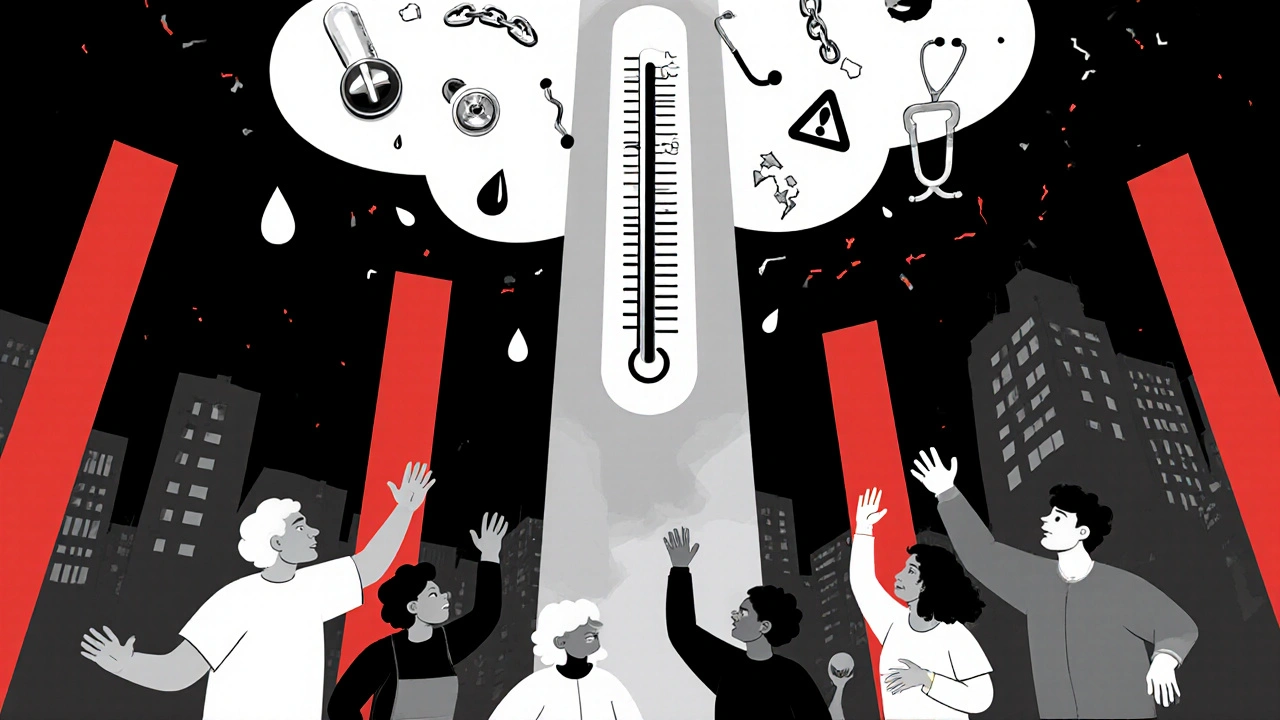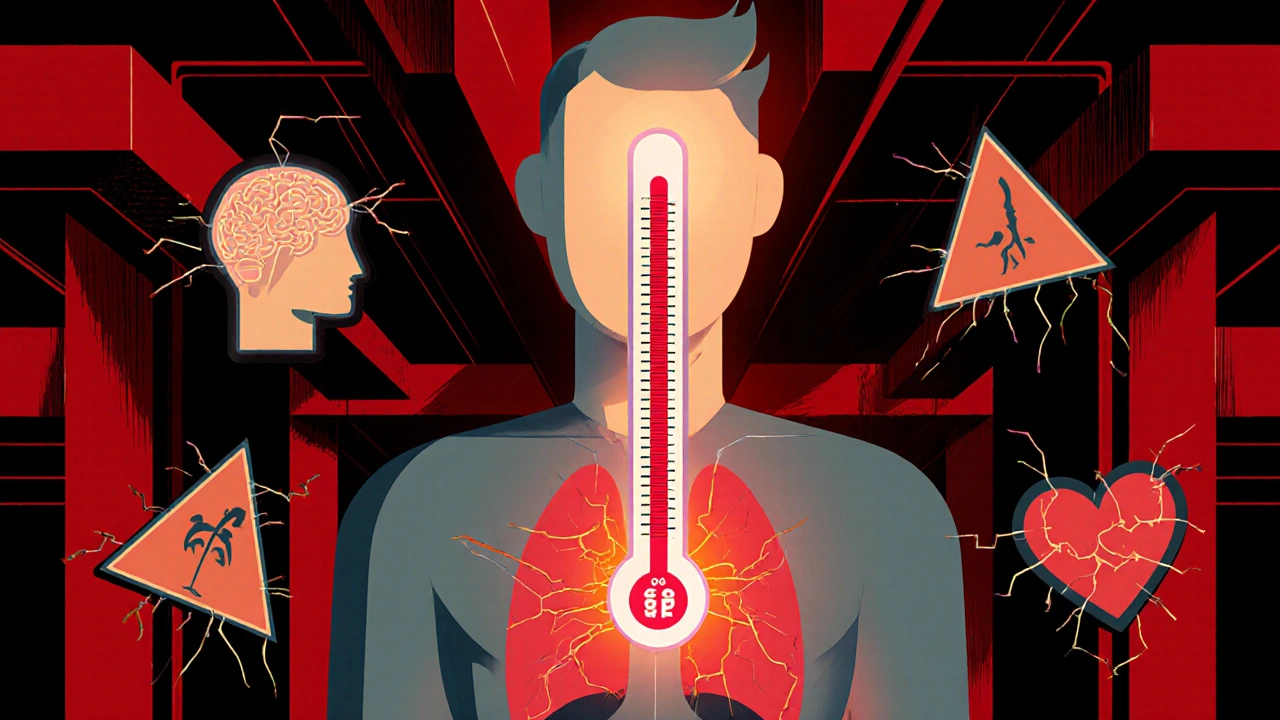Most adults know that a fever means something’s off. But how high is too high? How long is too long? And what symptoms should make you drop everything and call a doctor? The answer isn’t just about the number on the thermometer-it’s about context, timing, and your body’s warning signals.
What Counts as a Fever?
A fever isn’t just feeling hot. Medically, it’s defined as a body temperature of 100.4°F (38°C) or higher. That’s the standard used by hospitals, urgent care centers, and health systems across the U.S. But here’s the thing: not everyone runs at 98.6°F. Some people naturally run a little warmer or cooler. If you usually run at 97.8°F and suddenly hit 99.5°F, that could be your body’s signal that something’s wrong-even if it’s not technically a fever by the book.
Fevers happen because your immune system is fighting back. Your brain, specifically the hypothalamus, turns up the heat to make it harder for viruses or bacteria to survive. It’s not the enemy-it’s your body’s defense system in action. But that doesn’t mean every fever is harmless.
Temperature Levels and What They Mean
Not all fevers are created equal. Doctors break them down by severity:
- Low-grade: 99.1°F to 100.4°F (37.3°C to 38.0°C) - Often mild, common with colds or minor infections.
- Moderate: 100.6°F to 102.2°F (38.1°C to 39.0°C) - More noticeable, may come with chills, fatigue, or body aches.
- High-grade: 102.4°F to 105.8°F (39.1°C to 41°C) - A red flag. This level requires attention, especially if it lasts more than a day or two.
When you hit 103°F (39.4°C), it’s time to call your doctor-even if you feel okay otherwise. At 105°F (40.6°C), you need to go to the emergency room. Temperatures this high can stress your organs and increase the risk of neurological damage. This isn’t a myth-it’s backed by pathophysiology in major medical textbooks like Harrison’s Principles of Internal Medicine.
How Long Is Too Long?
Many people wait until the fever hits 104°F before doing anything. That’s too late. The real danger isn’t always the number-it’s the clock.
Most viral infections-like the flu or a bad cold-cause fevers that peak within 24 to 48 hours and fade by day three. If your fever is still going strong after 72 hours, you’re past the point where a simple virus explains it. That’s when bacterial infections, like pneumonia or a urinary tract infection that’s spread, become more likely.
Even if your temperature stays below 102°F, if it keeps coming back for a week or cycles every day, you need to get checked. Recurrent fevers can signal hidden problems like Lyme disease, endocarditis, or even certain cancers. The American College of Physicians says 90% of viral fevers resolve in 72 hours. If yours hasn’t, it’s not normal.

Red Flag Symptoms That Demand Immediate Care
A fever alone might be manageable. But when it shows up with certain symptoms, it’s not just a cold-it’s a medical emergency.
- Confusion, trouble waking up, or seizures - These mean your brain is under stress. Could be meningitis, sepsis, or encephalitis.
- Difficulty breathing or blue lips/tongue - Your body isn’t getting enough oxygen. This is life-threatening.
- Stiff neck or severe headache - Classic signs of meningitis. Don’t wait for the fever to spike.
- Rash that doesn’t fade when you press on it - Could be meningococcemia or toxic shock syndrome. Both are deadly if not treated fast.
- Severe abdominal pain, painful urination, or vaginal discharge with odor - These point to internal infections that can spread quickly.
- Inability to walk, urinate, or drink fluids - Your body is shutting down. Dehydration and organ strain are setting in.
These aren’t "maybe" symptoms. They’re clear, urgent signals. If you have a fever and any of these, don’t call your doctor’s office. Go to the ER or call 911.
Special Cases: Who Needs to Worry More?
If you’re over 65, or if you have a weakened immune system, your fever rules change.
People with cancer, HIV, organ transplants, or those on long-term steroids or chemotherapy should call their doctor at 101°F (38.3°C) or higher. Why? Because their bodies can’t fight infections the way a healthy person can. A fever that seems mild to you could be the first sign of a life-threatening infection.
The same goes for people with chronic conditions like diabetes, heart disease, COPD, or sickle cell anemia. Their systems are already under strain. A fever can tip them into crisis faster than you think.
During the pandemic, we saw this play out again and again. Older adults and immunocompromised patients who waited too long ended up in the hospital with preventable complications. CDC data showed that 18% of those hospitalizations could have been avoided with earlier evaluation.
How to Measure Your Temperature Accurately
Don’t rely on a forehead scanner if you’re trying to decide whether to go to the doctor. The most reliable way for adults is an oral digital thermometer. Place it under your tongue, close your lips, and wait for the beep.
Forehead (temporal artery) thermometers are convenient but less accurate. They can read 1°F lower than your true temperature. If you use one and get 101°F, your real temperature might be 102°F.
And don’t measure right after exercise, a hot shower, or being in a warm room. Wait at least 30 minutes. Heat from the environment can give you a false reading.

What to Do While You Wait
If your fever is below 103°F and you don’t have any red flag symptoms, you can manage it at home:
- Drink water, broth, or electrolyte drinks. Dehydration makes fevers worse.
- Rest. Your body needs energy to fight the infection.
- Take acetaminophen or ibuprofen if you’re uncomfortable. These don’t cure the fever-they just help you feel better.
- Wear light clothing. Don’t bundle up. Your body is trying to cool down.
But if you’re unsure-especially if you’re in a high-risk group-call your doctor or use a telehealth service. Many health systems now offer 24/7 virtual visits. You can get advice without leaving your house.
Why Waiting Is Risky
A 2022 study from the American Academy of Urgent Care Medicine found that 30% of adults waited longer than 72 hours before seeking help for a fever. Of those, nearly half ended up needing hospital care.
Another 2023 study showed that patients who waited more than 96 hours had more than double the chance of being hospitalized compared to those who came in within 72 hours.
And here’s the kicker: a Kaiser Permanente survey found that 42% of adults waited until their fever hit 104°F before doing anything. That’s not just risky-it’s dangerous. By then, the infection may have already spread.
Fever isn’t something to tough out. It’s a signal. Listen to it.
Is a fever of 103°F dangerous for an adult?
A fever of 103°F is high and should not be ignored. While healthy adults can sometimes tolerate short spikes up to 104°F without serious harm, a fever this high lasting more than a few hours requires medical evaluation. It’s a sign your body is fighting something serious-like a bacterial infection, pneumonia, or a severe viral illness. Contact your doctor or go to urgent care. Don’t wait for it to get worse.
Should I go to the ER if my fever is 104°F?
Yes. A fever of 104°F or higher is considered a medical emergency. At this temperature, your body’s proteins can start to break down, and your risk of neurological damage increases. Go to the ER immediately, especially if you’re confused, having trouble breathing, or have a rash, stiff neck, or seizure. Don’t wait for a ride-call 911 if you can’t get there safely.
Can a fever last more than 3 days without being serious?
It’s possible, but unlikely. Most viral infections causing fever resolve within 48 to 72 hours. If your fever lasts longer than that-even if it’s low-grade-it’s a red flag. It could mean a secondary bacterial infection, an abscess, or a chronic condition like Lyme disease or autoimmune inflammation. See a doctor. Don’t assume it’s "just a virus."
Is it safe to take medicine to lower a fever?
Yes, it’s safe to use acetaminophen or ibuprofen to reduce discomfort and help you rest. But don’t use them to hide the fever so you can keep going. The fever is your body’s way of fighting infection. Lowering it won’t cure the illness-it just makes you feel better. Use medicine for comfort, not to mask symptoms. If the fever comes back after the medicine wears off, that’s your body telling you it’s still fighting.
Do I need to go to the doctor if I have a fever but no other symptoms?
If your fever is under 103°F and you feel fine otherwise, you can wait 48 hours. But if it’s 103°F or higher, or if it lasts more than 72 hours-even with no other symptoms-you should get checked. Sometimes the only sign of a serious infection is fever. Conditions like endocarditis, tuberculosis, or hidden abscesses can present with fever alone.
Can stress or overwork cause a fever?
Stress alone doesn’t cause a true fever. You might feel hot or flushed, but your core body temperature won’t rise above 100.4°F unless there’s an infection, inflammation, or another medical cause. If you’re run down and have a low-grade fever, it’s likely your immune system is already dealing with a hidden infection. Don’t blame stress-get it checked.
What should I do if my fever comes back after going away?
A fever that returns after seeming to break is called a "relapsing fever." This is a classic sign of something deeper-like Lyme disease, malaria, typhoid, or even certain cancers. Don’t assume it’s just a cold coming back. See a doctor. You may need blood tests or imaging to find the root cause.
Final Takeaway
Fever isn’t the enemy. It’s a messenger. The problem isn’t the heat-it’s ignoring the message. If your fever is high, lasts too long, or shows up with strange symptoms, don’t wait. Don’t rely on guesswork. Use the numbers, the timing, and the warning signs as your guide. When in doubt, call your doctor. It’s not overreacting-it’s protecting your health.






I mean, sure, the article says 103°F is a red flag-but have you ever met someone who runs at 99°F and calls it a fever? My cousin in Delhi says she felt like she was dying at 99.8°F and took three days off work. Meanwhile, my uncle in Mumbai ran a 104°F fever during monsoon season and just drank buttermilk and watched cricket. We’re not lab rats. Your body knows its own business better than any algorithm.
November 21Erika Sta. Maria